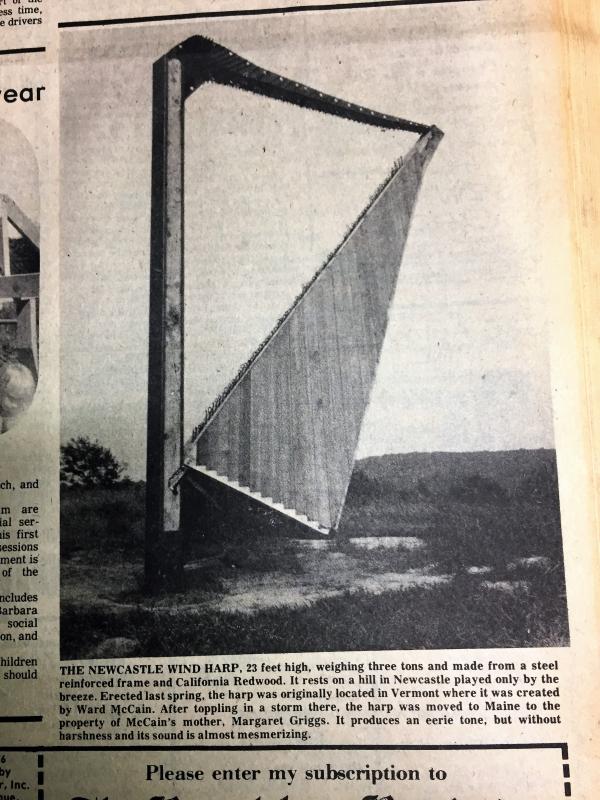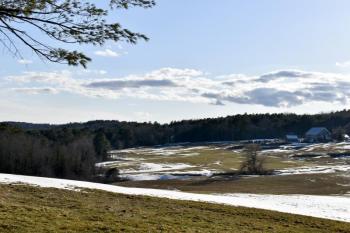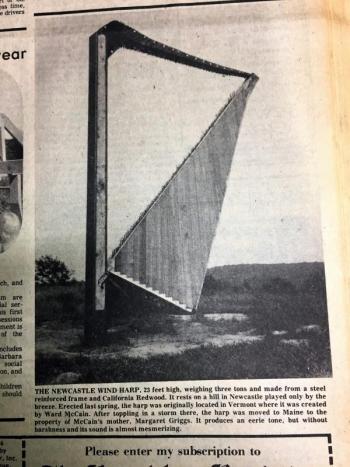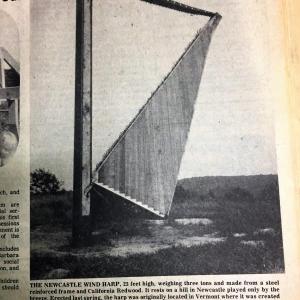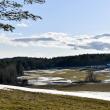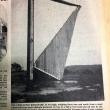Music made by the wind
Do you remember the big wind harp off the Cochran Road in Newcastle? It’s long gone but once upon a time it sat on top of a small knoll not too far over the Edgecomb town line just past where Watershed Center for the Ceramic Arts is now. The harp was placed there in the early 1970s and was still there in 1979 when I first saw it. It was about 20 feet tall and maybe 10 feet across at its widest point at the top. The frame was a combination of laminated wood and metal; it had steel strings.
As I said, the wind harp was in Newcastle, “East Newcastle” as it was known back in the old days, and not far from Station Road where the former train station was located. Back in the late 1930s and 40s the Maine Central Railroad used to stop here and pick up passengers. Rufus Caswell, a good friend and mentor whom I greatly miss, told me that when he was growing up in Edgecomb he used to ride the train from the East Newcastle Station to Lincoln Academy where he went to school. Except for his time spent in the military Rufus lived his whole life in Edgecomb and for many years delivered the mail here out of the old North Edgecomb Post Office.
I know I took a few pictures of the wind harp but just where those negatives disappeared to I don’t know. A few years back I took a digital picture of the harp but unfortunately that too has gone missing. My thinking at the time I copied the picture was to include it among the stories appearing in my first book. So it goes.
Here’s what I’ve pieced together about the wind harp. It was an Aeolian harp, that is to say a musical instrument that’s played by the wind. Its builder was Ward McCain, an artist from Vermont, possibly the Burlington area. The harp was first erected in Chelsea, Vermont in the early 1970s. Chelsea is small farming community in the state’s Woodstock-Quechee region. After a few years the harp was disassembled and carried to Newcastle where it was then reassembled. Always one to give credit where credit is due these facts came from an article appearing in the former Coastal Journal newspaper of Bath. The story written in 2016 was compiled by Chris Chase when the weekly newspaper was celebrating its 50th year in business. Chase writes the wind harp was placed on land owned by McCain’s mother, Margaret Griggs. It was Mrs. Griggs who later donated nearby property along the Sheepscot River to Midcoast Conservancy that became the Griggs Preserve, a place I’ve hiked a number of times. According to the Coastal Journal story the wind harp had 80 reinforced steel strings that could be “tuned” to produce a pleasant sound when the wind blew. It was moved from its Vermont location after the landowner there grew tired of people showing up at all hours of the day to listen to its music.
In his article Chris Chase included a few lines of a poem about the harp written by Edwin Merry of Edgecomb. Ed, an older man, was retired when I knew him and he lived with his wife Alice not far from where the wind harp was located. Alice, also in her 70s then, was active in the Lincoln Club and wrote an occasional column for my weekly newspaper the Wiscasset Times. Here’s part of Ed’s poem appearing in the Coastal Journal story:
Who would have guessed there’d rise a harp
Here on this upping land
Where men have stirred and cursed the wind
Where the railroad came for sand.
The “sand” the railroad carted away that Mr. Merry mentions was taken from this same area way, way back in the late 1860s. The fill was needed to help build the 4,000-foot long causeway across the cove linking the north end of Wiscasset to Clark’s Point. That’s where the iron draw bridge was built to carry trains over the Sheepscot River.
Eventually, I’ll get around to the “music” the wind harp made. If you grew up in this area in the 1970s you probably remember the harp. John Merry, a Wiscasset native (no relation to Ed Merry), said when he was in high school the big harp was a place where he and his friends sometimes gathered to enjoy a Saturday night. “It was kind of secluded but just about everybody knew about it.” he said. The Cochran Road is still a bit off the beaten path, twisting and turning through woods, meadows and marshland before eventually becoming Station Road on its return to Route 1.
Steve Christiansen of Willow Lane, Wiscasset told me he can see the wind harp in his mind’s eye. “I remember driving over there dozens of times with my friends when I was in high school and listening to the really weird sounds it made. If the wind was blowing hard, the sound from it carried quite a ways.” Steve added on a warm summer night there’d almost always be young people gathered there.
“Mesmerizing, really beautiful, and truly magical,” is how Gail Boudin remembers the harp. Gail who by the way is Rufus Caswell’s daughter, said when she was dating her husband Tom Boudin they loved to drive by the harp at sundown and see it silhouetted against the evening sky. If the wind was whipping, its strange music filled the valley surrounding it. “Tom remembers it too. It was something special and I bet there’re a lot of other people who remember it and wish it was still there.”
I’m not sure when the wind harp was taken down – maybe 1980 or ’81. I think it might have been taken next to New Hampshire where it was reassembled to make more music. As I recall it had gotten to where it needed more than just minor repairs.
Now about the sounds it made. I wouldn’t exactly call it music. If you’re curious, you can hear a five-minute recording on YouTube by going to “The Wind Harp – Song from the Hill.” This recording comes from a double album released in 1972 on United Artist Records. The liner notes state the album was tape-recorded on location in Edgecomb, not Newcastle and features 10 tracks. Among the titles are, “Solstice/Summer Song,” “Winterwhite” and “Circle’s End.” With that said, the color picture on the album cover doesn’t quite look like the wind harp in Newcastle, not as I remember it. Maybe the picture was taken when the harp was still new and located in Vermont.
Phil Di Vece earned a B.A. in journalism studies from Colorado State University and an M.A. in journalism at the University of South Florida. He is the author of three Wiscasset books and is a frequent news contributor to the Boothbay Register-Wiscasset Newspaper. He resides in Wiscasset at the foot of Langdon Mountain. Contact him at pdivece@roadrunner.com



